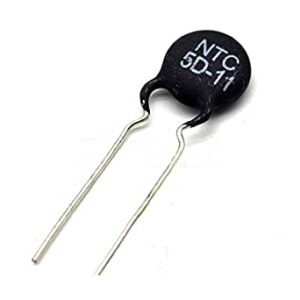Thermistor
Thermistors are variable resistors that change their resistance with temperature. They are classified by the way their resistance responds to temperature changes. In Negative Temperature Coefficient (NTC) thermistors, resistance decreases with an increase in temperature. In Positive Temperature Coefficient (PTC) thermistors, resistance increases with an increase in temperature.
NTC thermistors are the most common, and that’s the type we’ll be using in this tutorial. NTC thermistors are made from a semiconducting material (such as a metal oxide or ceramic) that’s been heated and compressed to form a temperature sensitive conducting material.
The conducting material contains charge carriers that allow current to flow through it. High temperatures cause the semiconducting material to release more charge carriers. In NTC thermistors made from ferric oxide, electrons are the charge carriers. In nickel oxide NTC thermistors, the charge carriers are electron holes.
Showing all 9 results
-

KY-013 Analog Temperature Sensor Module
Read more -


NTC thermistor SCK0120 1 Ohm 20A
Read more -


Thermistor Resistor NTC 5D-15 Thermal Resistor
Read more -


Thermistor Resistor NTC 5D-11 Thermal Resistor
Read more -


NTC-503-R Thermistor, Negative Temperature Coefficient K, 50k Ohm
Read more -




NTC-502-R Thermistor, Negative Temperature Coefficient K, 5k Ohm
Read more -




NTC-103-R Thermistor, Negative Temperature Coefficient K, 10k Ohm
Read more -




NTC-102-R Thermistor, Negative Temperature Coefficient K, 1k Ohm
Read more -


KY-028 Digital Temperature Sensor Module
Read more
